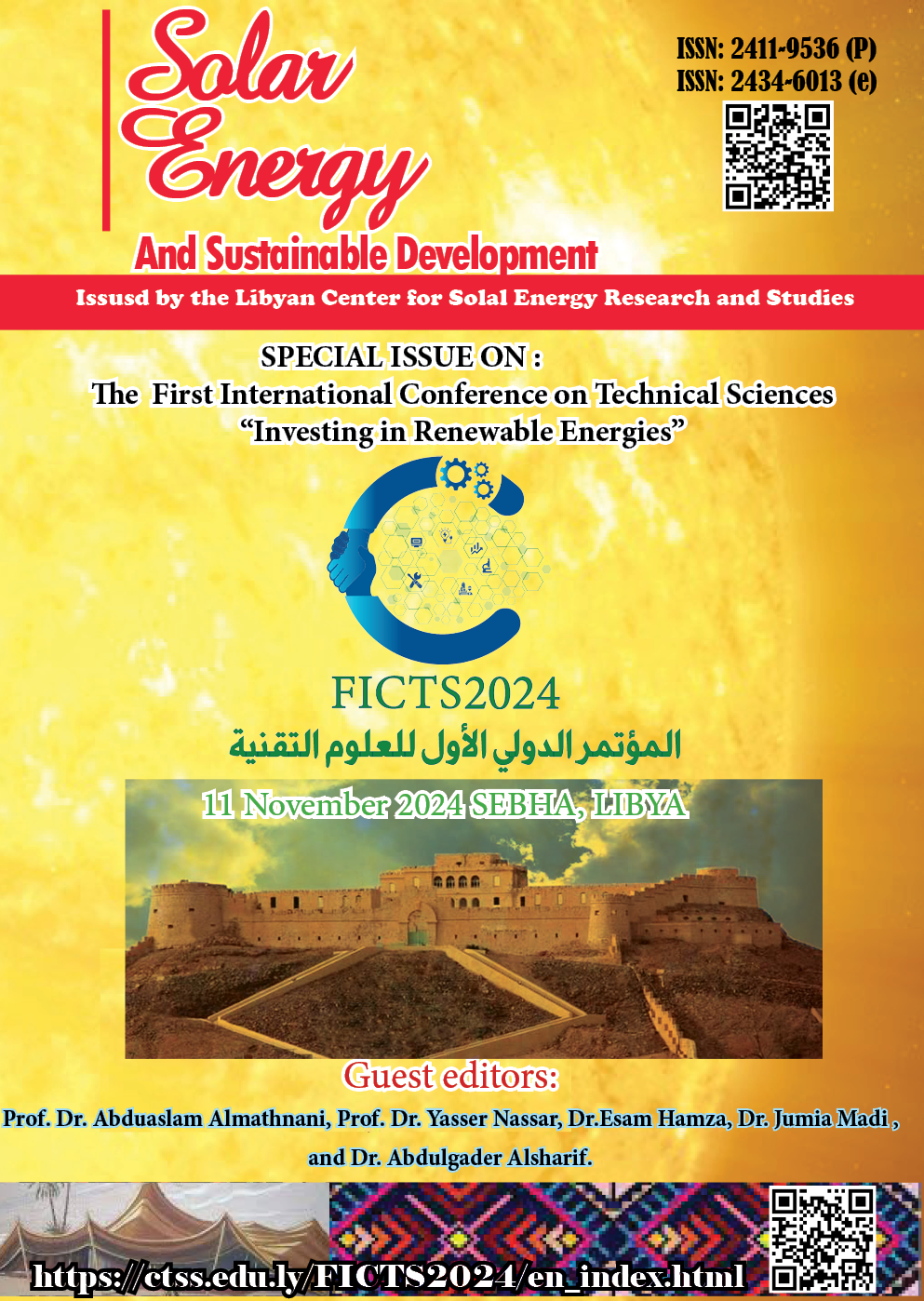Utilizing Geographic Information Systems to Identify Optimal Locations for Establishing Solar Power Plants in the Sebha Region
DOI:
https://doi.org/10.51646/jsesd.v14iFICTS-2024.442Keywords:
Solar energy, Geographic Information Systems, Multi-criteria, Optimal sites, Sebha regioAbstract
This study aims to determine the most suitable location for establishing solar power stations in the Sebha region using Geographic Information Systems (GIS). It focuses on integrating geographic and climatic data and applying specific criteria to evaluate the spatial suitability for these stations. The study aims to leverage the region's natural potential by utilizing solar radiation and guiding decision-makers towards optimal sites that offer economic and environmental efficiency. The study used a descriptive-analytical approach and applied several criteria in the analysis, such as solar radiation, slope degree, proximity to transportation and energy networks, and distance from urban areas. The Multi-Criteria Evaluation (MCE) method was also applied within the GIS environment to assess suitable areas. The results showed that climatic factors, such as solar radiation, temperature, and wind, play a crucial role in determining site suitability for solar power stations. The study utilized a Digital Elevation Model (DEM) of the region to produce maps using Spatial Analyst tools within the Arc Map 10.8 package, along with land use maps to create a spatial suitability map. The spatial suitability results for establishing a solar power station indicated that highly suitable areas constitute about 60% of the total studied area, while moderately suitable areas represent around 22%, and areas with low suitability cover approximately 18% of the total area. These findings support efforts to diversify energy sources and establish a scientifically-based database that promotes renewable energy use and sustainable development in the region.
Downloads
Metrics
References
- الحلفي، عبدالجبار عبود علي، تطورات الطاقة المتجددة في دولة الإمارات العربية المتحدة مع الإشارة خاصة بالطاقة الشمسية، مجلة الخليج العربي، المجلد (40) العدد (3-4) سنة 2012.ص 3-6
- داود، جمعة محمد وآخرون، تحديد أفضل المواقع لتجميع الطاقة الشمسية في منطقة مكة المكرمة الإدارية باستخدام نظم المعلومات الجغرافية متعددة المعايير، الملتقى الوطني الحادي عشر لتطبيقات نظم المعلومات الجغرافية في المملكة العربية السعودية، جامعة الإمام الملك فيصل 11-13 أبريل 2017م ، ص 7.
- طه، دلير عزيز، وآخرون ، المقومات الجغرافية لإنشاء محطات توليد الطاقة الكهربائية من الإشعاع الشمسي، المجلة الأكاديمية لجامعة نوروز، العراق، 2017.ص12.
- قلية، منصور علي، إمكانيات استخدام الطاقة الشمسية في ليبيا دراسة في جغرافية الخدمات، مجلة كليات التربية، 2017 ص ص 4-7
- الطائي، عباس فاضل، تقييم الملاءمة المكانية لمحطات توليد الطاقة الكهربائية في محافظة القادسية باستعمال GIS ، مجلة القادسية للعلوم الإنسانية ، المجلد (21) العدد 91، 2018. ص6
- الزردومي، وآخرون، تقدير الإشعاع الشمسي واختيار أنسب المواضع لمحطات الطاقة الشمسية ، منشورات جامعة طبرق، المجلد الثاني، الطبعة الأولي، 2022. ص4.
- Zulkifly, M. I. D., Said, M. S. M. (2022). Determining Optimal Solar Power Plant Location in Melaka, Malaysia: A GIS-Based Solutions, IOP Conf. Series: Earth and Environmental Science, pp. 1-16
- آل مشيط، أمل بنت حسين، الملاءمة المكانية لتحديد أنسب المواقع الطاقة الشمسية في منطقة عسير، المجلة الجغرافية العربية، المجلد (55) العدد(83) يونيو،2024. ص ص189-204 DOI: https://doi.org/10.21608/agj.2024.241260.1197
- هيئة المساحة الجيولوجية الأمريكية www.USGS.com-
- ألحلفي، عبدالجبار عبود علي، مرجع سابق ص 13
- داود، جمعة محمد وآخرون، مرجع سابق ص 3
- كمال، محمد ، وآخرون، واقع وأفاق الطاقة المتجددة في الدول العربية، الطاقة الشمسية وسبل تشجيعها، المؤتمر العلمي الدولي للتنمية المستدامة والكفاءة الاستخدامية للمواد المتاحة، سيطيف، الجزائر، أبريل، 2008،ص4 .
- Dawod , G, and Mandoer, M.( 2016), Optimum sites for solar energy harvesting in Egypt based on multi-criteria GIS, The first Future University international,P13
- زرزار العياشي، وآخرون، الاستثمار في الطاقات المتجددة وآلية لرفع معدلات النمو الاقتصادي للدول العربية، مجلة الطاقة الشمسية والتنمية المستدامة، مجلة علمية محكمة تصدر عن مركز بحوث الطاقة الشمسية المجلد(5) العدد (1)2016. DOI: https://doi.org/10.51646/jsesd.v5i1.69
- عبد العزيز طريح شرف، ( 1996)، جغرافيا ليبيا، الطبعة الثالثة، مركز الإسكندرية للكتاب، الإسكندرية.، ص ص 285- 314.
- Y. Nassar, Solar energy engineering – active applications, Sebha University, Sebha, Libya, 2006
- Zulkifly, M. I. D., Said, M. S. Mthe previous reference,p,3
- . المركز الوطني للأرصاد الجوية،( 2023)، إدارة الخدمات، قسم العمليات المناخية، بيانات غير منشورة، طرابلس
- Hosseini, A. A., & Hosseini, S. H. (2012). Utilizing solar energy instead of fossil fuels as domestic energy (case study Dehloran city, Ilam province, Iran). Energy exploration & exploitation, 30(3), 389-401. DOI: https://doi.org/10.1260/0144-5987.30.3.389
- Taher, M. A., & Fares, M. N. (2017). Experimental investigation of solar energy storage using paraffin wax as thermal mass. International Journal of Renewable Energy
- آل مشيط، أمل بنت حسين، مرجع سابق ص 198
- Sassi Rekik, Souheil El Alimi. Optimal wind-solar site selection using a GIS-AHP based approach: A case of Tunisia. Energy Conversion and Management: X. volume 18 april2023,100355. DOI: https://doi.org/10.1016/j.ecmx.2023.100355
- كمال، محمد ، وآخرون،مرجع سابق ص 11.
- آل مشيط، أمل بنت حسين، مرجع سابق ص 203
- مصلحة التخطيط العمراني، فرع المنطقة الجنوبية.
- Fan,B,( 2009), A hybrid spatial data clustering method for site selection : the data driven approach of GIS mining , volume : 36 , lssue : 2,pudlisher : Elsvier Ltd DOI: https://doi.org/10.1016/j.eswa.2008.02.056
- Al Garni, H.Z.; Awasthi, A. Solar PV power plant siteselection using a GIS-AHP based approach with application inSaudi Arabia. Appl. Energy 2017, 206, 1225–1240. DOI: https://doi.org/10.1016/j.apenergy.2017.10.024
- داود، جمعة محمد وآخرون، مرجع سابق ص 7.
Downloads
Published
How to Cite
Issue
Section
License
Copyright (c) 2025 Solar Energy and Sustainable Development Journal

This work is licensed under a Creative Commons Attribution-NonCommercial 4.0 International License.














